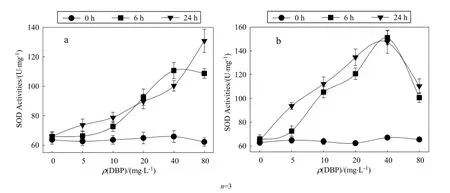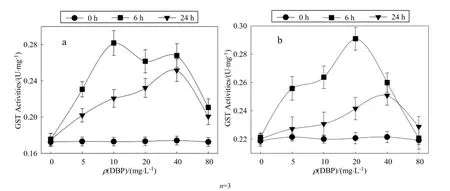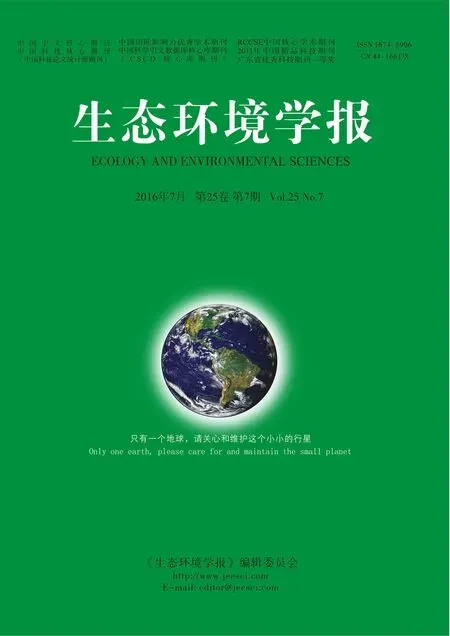两种典型细菌的生长和氧化应激酶对邻苯二甲酸二丁酯的响应
胡影,王志刚,徐伟慧,胡云龙,刘帅,由义敏,赵晓松,苏云鹏
两种典型细菌的生长和氧化应激酶对邻苯二甲酸二丁酯的响应
胡影,王志刚*,徐伟慧,胡云龙,刘帅,由义敏,赵晓松,苏云鹏
齐齐哈尔大学生命科学与农林学院,黑龙江 齐齐哈尔 161006
邻苯二甲酸二丁酯(Di-n-butyl phthalate,DBP)是一种广泛存在于环境中的有机污染物,对环境构成严重威胁,现已被中国环境监测中心列入优先控制污染物名单。本研究从黑土中分离出两种典型细菌B. subtilis D13和E. coli Q5,以液体培养法接种于添加不同质量浓度(0、5、10、20、40、80 mg·L-1)DBP的LB培养基中,测定两种菌株的生长曲线;以分光光度法测定其氧化应激酶系对DBP胁迫的应答反应。结果表明,(1)DBP污染可抑制细菌生长,在对数生长期抑制作用显著,但随着污染时间的延长,B. subtilis D13菌株生长量呈恢复趋势,抑制作用减缓;DBP污染对E. coli Q5的抑制作用更为显著,且菌株生长未出现恢复趋势。(2)经DBP培养,6 h时两种菌株的抗氧化应激酶对污染出现应答反应,SOD活性随着污染物浓度的升高而增加。(3)两种细菌的CAT、GST活性与SOD活性的变化趋势基本一致,酶活呈现DBP低浓度诱导而高浓度抑制的趋势。实验结果可为进一步研究DBP对微生物的生态毒理效应提供理论基础。
邻苯二甲酸二丁酯(DBP)污染;细菌的氧化应激酶活性
引用格式:胡影, 王志刚, 徐伟慧, 胡云龙, 刘帅, 由义敏, 赵晓松, 苏云鹏. 两种典型细菌的生长和氧化应激酶对邻苯二甲酸二丁酯的响应[J]. 生态环境学报, 2016, 25(7): 1225-1229.
HU Ying, WANG Zhigang, XU Weihui, HU Yunlong, LIU Shuai, YOU Yim in, ZHAO Xiaosong, SU Yunpeng. Response of Bacterial Grow th and the Activities of Oxidative Enzymes to Di-n-butyl Phthalate Contam ination [J]. Ecology and Environmental Sciences,2016, 25(7): 1225-1229.
邻苯二甲酸酯(Phthalate esters,PAEs)类化合物作为塑料制品的成型剂而被广泛使用(Xia et al.,2011),而邻苯二甲酸二丁酯(Di-n-butyl phthalate,DBP)是PAEs中应用最为广泛的一种。由于塑料制品的长期大量使用,DBP已成为我国最为普遍的有机污染物之一,在土壤、水体、空气以及沉积物中均被检出(Kong et al.,2012;Sun et al.,2013;He et al.,2015)。土壤中的DBP源自于农膜、农药、杀虫剂和化肥等的使用,其中农膜是导致其含量超标的主要原因(Wang et al.,2015;Zhang et al.,2015a),且与塑料薄膜的使用量有显著关联性(Wang et al.,2013)。目前,我国部分东北黑土的DBP平均污染含量为7.60 mg·kg-1(Xu et al.,2008),远超美国环保署制定的安全标准(Niu et al.,2014;朱媛媛等,2012),已对黑土肥力和生产力构成严重威胁。
土壤微生物是土壤生态系统的重要组成成分,可参与土壤的物质循环,并优化土壤生态,是评价土壤健康及土壤生态系统功能的重要指标(宋长青等,2013;Diacono et al.,2010)。前人在群体水平上的研究发现,PAEs类污染可抑制黑土微生物的呼吸速率与微生物代谢熵(王志刚等,2015a),DBP污染能改变黑土功能微生物的丰度与黄瓜根际微生物群落结构(王志刚等,2015b;Zhang et al.,2015b),然而,单一种类微生物对DBP污染的响应过程尚不明确。生物体的抗氧化应激酶包括超氧化物歧化酶(SOD)、过氧化物酶(CAT)和谷胱甘肽硫转移酶(GST)等,他们对环境胁迫尤为敏感,其活性可被氧化应激所诱导而做出积极的应答反应。因此,研究黑土典型微生物的生长和抗氧化应激酶对DBP污染的响应,对于阐明DBP的生态毒理效应具有重要意义。
1 材料与方法
1.1菌株与菌体收集
革兰氏阳性菌株B. subtilis D13和革兰氏阴性菌株E. coli Q5均从齐齐哈尔市克山县黑土耕层中分离纯化,由齐齐哈尔大学环境微生物实验室保存。将分离的菌株接种于LB培养基(pH 7.0)中活化,30 ℃、转速130 r·m in摇床培养。
1.2生长曲线测定
DBP(纯度≥99.9%)购于中国标准物样品信息中心,助溶剂为丙酮,制备成1000 mg·L-1储备液,于4 ℃冰箱保存备用。将处于对数生长期的菌株按2%的接种量接入添加不同质量浓度(0、5、10、20、40、80 mg·L-1)DBP的LB培养基(pH 7.0)中,30 ℃下振荡培养;于600 nm波长下测定菌液吸光值,以0 mg·L-1DBP为空白对照,每处理3组平行。
1.3粗酶液制备与酶活性测定
分别于0、6、24 h吸取细菌培养液,参照王志刚等(2015c)的方法制备粗酶液。以DBP处理0 h为对照,每处理3组平行。
采用南京建成生物工程研究所生产的试剂盒,参照说明书测定抗氧化酶活性。3种酶的酶活单位(U·mg-1)定义为:以1 m L反应液中SOD抑制率达50%时所对应的SOD量为一个SOD活力单位(U);以1 mg蛋白或血红蛋白中过氧化氢酶(CAT)在 1 s内分解吸光度为0.50~0.55的底物中的过氧化氢相对量为一个酶活力单位;以1 mg蛋白在37 ℃反应l m in,扣除非酶促反应,使反应体系中GSH浓度降低1 μmol·L-1为一个酶活力单位。蛋白含量的测定采用Bradford(1976)法,以牛血清蛋白为标准蛋白。
1.4数据统计
所有实验数据均采用SPSS 17.0软件进行统计分析,采用Sigma Plot 12.5进行图表绘制。
2 结果与分析
2.1细菌生长对DBP的响应
由图1可知,添加不同质量浓度DBP,均对B. subtilis D13和E. coli Q5产生了抑制效应。初始4 h为细菌生长迟缓期,DBP的抑制作用较弱,而在进入对数生长期后,细菌生长受到明显抑制,且抑制作用随DBP质量浓度的增加而逐渐增强。细菌到达生长平稳期后,各处理组的细菌生长量虽低于对照,但随时间推移B. subtilis D13生长量呈恢复增加的趋势(图1a)。与B. subtilis D13相比,DBP对E. coli Q5的抑制效应更为显著,且抑制作用随DBP污染浓度的增加而增强,平稳期细菌生长未出现恢复增加趋势(图1b)。
2.2细菌SOD酶活力对DBP的响应
B. subtilis D13和E. coli Q5的SOD酶活力对DBP的响应如图2。对照组(0 mg·L-1)的SOD酶活力低于DBP处理组,而DBP处理6 h和24 h的SOD活性呈不同程度的增加趋势。DBP质量浓度为5~40 mg·L-1时,随着污染浓度的升高,B. subtilis D13的SOD酶活性增加,并在40 mg·L-1处达到最大值(110.73 U·mg-1);在培养24 h时,B. subtilis D13的SOD活性随着处理浓度的升高(20~80 mg·L-1)而持续升高,且在80 mg·L-1处仍呈上升趋势,酶活性为130.86 U·mg-1(图2a)。DBP处理6 h和24 h时,E. coli Q5的SOD酶活力随污染浓度的升高而增加,40 mg·L-1处理的SOD酶活力最大,分别为151.18 U·mg-1和147.46 U·mg-1,随后SOD活性降低(图2b)。

图1 DBP污染对B. sub tilis D13(a)和E. coli Q 5(b)生长的影响Fig. 1 Impact of DBP contam ination on the grow th of B. subtilis D13 (a) and E. coli Q5 (b)
2.3细菌CAT酶活力对DBP的响应
由图3可知,DBP处理的B. subtilis D13和E. coli Q5的CAT活性均高于对照组。处理6 h时,在DBP质量浓度在5~40 mg·L-1范围内,B. subtilis D13的CAT活性随处理浓度的升高而增加,之后酶活性随处理浓度的升高而降低,40 mg·L-1处理CAT活性达最大值(0.62 U·mg-1);培养24 h时,B. subtilis D13的CAT活性变化趋势与DBP处理6 h时大致相同,40 mg·L-1处理的CAT活性为0.48 U·mg-1(图3a)。处理6 h时,E. coli Q5在DBP质量浓度为20 mg·L-1时,CAT活性达到最大值(0.90 U·mg-1),之后CAT活性随处理浓度升高而降低;而DBP处理24 h时,E. coli Q5的CAT活性无显著变化(图3b)。
2.4细菌GST酶活力对DBP的响应
DBP处理6 h时的GST活性增加幅度与24 h时的相比差别较大,在DBP质量浓度为5~40 mg·L-1时,B. subtilis D13的GST活性随污染物浓度的升高而增加,10 mg·L-1处理GST活性达最大值(0.28 U·mg-1),而处理24 h时,GST活性最大值出现在40 mg·L-1处理组(0.26 U·mg-1)(图4a)。E. coli Q5 GST活性变化趋势与B. subtilis D13大致相同,但DBP处理6 h时,GST活性在20 mg·L-1处理出现最大值(0.29 U·mg-1),24 h时GST活性在40 mg·L-1处理出现最大酶活(0.25 U·mg-1),之后GST活性随污染物浓度的升高而降低(图4b)。

图2 B. subtilis D13(a)和E. co li Q5(b)SOD活性的变化Fig. 2 Variation of SOD activities in B. subtilis D13 (a) and E. coli Q5 (b)

图3 B. subtilis D13(a)和E. coli Q5(b)CAT活性的变化Fig. 3 Variation of CAT activities in B. subtilis D13 (a) and E. coli Q5 (b)
3 讨论
微生物是土壤生态系统中不可缺少的重要成分,可参与土壤营养元素循环与多种生物化学反应,在优化土壤生态功能与维持黑土肥力等方面具有至关重要的作用(王志刚等,2012;Graham et al.,2014),同时,微生物的物种和功能多样性是评价土壤质量的重要指标(Qiu et al.,2012)。最新研究表明,DBP可以干扰黑土微生物的代谢活动,改变微生物的群落结构,并且随DBP浓度的升高,细菌的多样性显著下降(Wang et al.,2016)。DBP污染可使土壤细菌总量和种群发生变化,但对单一细菌种类是否会产生影响,同时单一细菌会对DBP污染胁迫做出何种应答尚不明确。因此,本研究通过监测DBP污染下黑土典型革兰氏阳性细菌B. subtilis D13和革兰氏阴性细菌E. coli Q5的生长及抗氧化应激酶活性的变化,探究单一细菌对DBP的响应。本实验中,经不同浓度DBP处理后,B. subtilis D13和E. coli Q5的生长受到不同程度的抑制,抑制作用与处理浓度呈正相关;DBP对E. coli Q5抑制作用较强,而对B. subtilis D13抑制作用较弱。原因可能是B. subtilis D13为革兰氏阳性菌,细胞壁比阴性菌的厚,且可产生芽孢,对不利环境有更强的适应性与抗性(Edvantoro et al.,2003)。同时,污染物也可能在微生物的细胞质膜上累积,并降低质膜的流动性(Sun et al.,2006)。因此,DBP可能更易在E. coli Q5中积累并抑制其生长。
微生物在代谢过程中会积累少量的活性氧,正常情况下,活性氧与抗氧化应激酶之间处于动态平衡,但当活性氧过量累积时,抗氧化应激酶就会通过代偿机制被激活(Cartw right et al.,2000)。SOD作为O2-专一的清除剂,O2-胁迫应急响应中首先合成的是SOD,并通过歧化反应迅速将O2-转化为H2O2,随后CAT对H2O2进行分解,从而消除胁迫效应(燕国梁,2006)。本实验中,DBP污染可提高细菌SOD和CAT活性,且CAT与SOD具有相同的变化趋势,呈现低浓度促进高浓度抑制的趋势,与秦洁芳等(2011)的研究结果相同,但与王志刚等(2015c)的研究结果不尽相同。与CAT对DBP污染的响应结果相比,DMP污染引起CAT活性呈低浓度激活而高浓度抑制的变化趋势,产生此结果的原因可能与污染物的化学结构不同有关。DMP是PAEs类污染物中结构最简单、水溶性最高的一类,与DBP相比,更易与细菌接触并进入胞内而迫使细菌对H2O2胁迫做出应答。GST可催化谷胱甘肽(GSH)与亲电性中间代谢产物结合,在减轻氧化胁迫与解毒方面具有重要作用。本实验中,GST活性随污染物浓度的升高而增加,且处理6 h的GST活性高于24 h。穆景利等(2009)研究苯并[a]芘对黑鲷肝脏GST活性影响的实验结果显示黑鲷肝脏GST活性可在较短的时间内被诱导,且诱导效应在初期高于后期,与本实验结果一致,说明污染物浓度与处理时间是诱导GST活性的重要因素。与B. subtilis D13相比,E. coli Q5的GST活性较高,也说明DBP对E. coli Q5的胁迫作用较大,E. coli Q5的GST活性对DBP胁迫的响应程度高于B. subtilis D13。
综上所述,DBP污染对细菌的生长有抑制作用,细菌抗氧化应激酶(SOD、CAT、GST)活性总体表现出低浓度激活而高浓度抑制的趋势,3种酶协同作用消除因胁迫产生的氧化损伤,对DBP污染做出应答响应,说明DBP污染会引起细菌的氧化损伤,但其损伤机制仍有待进一步研究。

图4 B. subtilis D13(a)和E. co li Q 5(b)GST活性的变化Fig. 4 Variation of GST activities in B. subtilis D13 (a) and E. coli Q5 (b)
4 结论
DBP污染可抑制细菌的生长,细菌抗氧化应激酶在短期内升高,对DBP污染做出应答响应。由此认为,DBP污染可改变单一细菌的生长状况,进而影响土壤微生物群落的稳定性。
致谢:诚挚感谢Kui Chen教授在论文写作过程中提供宝贵意见!
BRADFORD M M. 1976. A rapid and sensitive method for the quantitation of m icrogram quantities of protein utilizing the principe of protein-dye binding [J]. Analytical Biochemistry, 72(1-2): 248-254.
CARTWRIGHT C D, THOMPSON I P, BURNS R G. 2000. Degradation and impact of phthalate plasticizers on soil microbial communities [J]. Environmental Toxicology and Chem istry, 19(5): 1253-1261.
DIACONO M, MONTEMURRO F. 2010. Long-term effects of organic amendments on soil fertility: A review [J]. Agronomy for Sustainable Development, 30(2): 401-422.
EDVANTORO B B, NAIDU R, MEGHARAJ M, et al. 2003. Change in microbial properties associated with long-term arsenic and DDT contaminated soils at disused cattle dip sites [J]. Ecotoxicology andEnvironmental Safety, 55(3): 344-351.
GRAHAM E B, WOEDER W R, LEFF J W, et al. 2014. Do you need to understand microbial communities to predict ecosystem function? A comparison of statistical models of nitrogen cycling processes [J]. Soil Biology and Bio-chemistry, 68(1): 279-282.
HE L, GIELEN G, BOLAN N S, et al. 2015. Contamination and remediation of phthalic acid esters in agricultural soils in china: a review [J]. Agronomy for Sustainable Development, 35(2): 519-534.
KONG S, JI Y, LIU L, et al. 2012. Diversities of phthalate esters in suburban agricultural soils and wasteland soil appeared with urbanization in China [J]. Environmental Pollution, 170: 161-168.
NIU L, YANG X, CHAO X, et al. 2014. Status of phthalate esters contamination in agricultural soils across China and associated health risks [J]. Environmental Pollution, 195: 16-23
QIU M H, ZHANG R F, XUE C, et al. 2012. Application of bio-organic fertilizer can control Fusarium wilt of cucumber plants by regulating microbial community of rhizosphere soil [J]. Biology & Fertility of Soils, 48(7): 807-816.
SUN J, HUANG J, ZHANG A, et al. 2013. Occurrence of phthalate esters in sediments in Qiantang River, China and inference with urbanization and river flow regime [J]. Journal of hazardous materials, 248-249:142-149.
SUN Y Y, YU H X, ZHANG J F, et al. 2006. Bioaccumulation, depuration and oxidative stress in fish Carassius auratus under phenanthrene exposure [J]. Chemosphere, 63(8): 1319-1327.
WANG J, CHEN G, CHRISTIE P, et al. 2015. Occurrence and risk assessment of phthalate esters (PAEs) in vegetables and soils of suburban plastic film greenhouses [J]. Science of The Total Environment, 523: 129-137.
WANG J, LUO Y M, TENG Y, et al. 2013. Soil contamination by phthalate esters in Chinese intensive vegetable production systems with different modes of use of plastic film [J]. Environmental Pollution, 180(3):265-273.
WANG Z G, LIU S, XU W H, et al. 2016. The microbiome and functions of black soils are altered by dibutyl phthalate contamination [J]. Applied Soil Ecology, 99: 51-61.
XIA X, YANG L, BU Q, et al. 2011. Levels, distribution, and health risk of phthalate esters in urban soils of Beijing, China [J]. Journal of environmental quality, 40(5): 1643-1651.
XU G, LI F, WANG Q, et al. 2008. Occurrence and degradation characteristics of dibutyl phthalate (DBP) and di-(2-ethylhexyl)phthalate (DEHP) in typical agricultural soils of China [J]. Science of The Total Environment, 393(2): 333-340.
ZHANG Y, TAO Y, ZHANG H, et al. 2015b. Effect of di-n-butyl phthalate on root physiology and rhizosphere microbial community of cucumber seedlings [J]. Journal of hazardous materials, 289: 9-17.
ZHANG Y, WANG P, WANG L, et al. 2015a. The influence of facility agriculture production on phthalate esters distribution in black soils of northeast China [J]. Science of the Total Environment, 506-507:118-125.
穆景利, 王新红, 林建清, 等. 2009. 苯并[a]芘对黑鲷肝脏GST活性的影响及其与肝脏代谢酶和胆汁代谢产物之间的变化关系[J]. 生态毒理学报, 4(4): 516-523.
秦洁芳, 陈海刚, 蔡文贵, 等. 2011. 邻苯二甲酸二丁酯对翡翠贻贝抗氧化酶及脂质过氧化水平的影响[J]. 应用生态学报, 22(7):1878-1884.
宋长青, 吴金水, 陆雅海, 等. 2013. 中国土壤微生物学研究10年回顾[J]. 地球科学进展, 28(10): 1087-1105.
王志刚, 胡影, 崔竞文. 2015c. 邻苯二甲酸二甲酯对典型细菌生长和氧化应激酶系的影响[J]. 生态毒理学报, 10(3): 297-303.
王志刚, 胡影, 徐伟慧, 等. 2015a. 邻苯二甲酸二甲酯污染对黑土土壤呼吸和土壤酶活性的影响[J]. 农业环境科学学报, 34(7): 1311-1316.
王志刚, 徐伟慧, 莫继先, 等. 2012. 东北黑土区大豆根际促生菌群落组成研究[J]. 中国生态农业学报, 20(5): 592-596.
王志刚, 由义敏, 徐伟慧, 等. 2015b. 黑土微生物丰度和多样性对邻苯二甲酸二甲酯污染的响应[J]. 生态环境学报, 24(10): 1725-1730.
燕国梁. 2006. 活性氧胁迫下Bacillus sp. F26以过氧化氢酶合成为特征的应激响应[D]. 无锡: 江南大学.
朱媛媛, 田靖, 景立新, 等. 2012. 不同城市功能区土壤中酞酸酯污染特征[J]. 环境科学与技术, 35(5): 42-46.
Response of Bacterial Growth and the Activities of Oxidative Enzymes to Di-n-butyl Phthalate Contamination
HU Ying, WANG Zhigang*, XU Weihui, HU Yunlong, LIU Shuai, YOU Yimin, ZHAO Xiaosong, SU Yunpeng
Institute of Life Science and Agriculture and Forestry, Qiqihar University, Qiqihar 161006, China
Di-n-butyl phthalate (DBP) is a ubiquitous organic pollutant in black soil. Because it is widely detected in China's agricultural soil, DBP has been listed as an environmental priority pollutant by China State Environmental Protection Administration. The purpose of the study was to estimate the responses of the growth and activities of oxidative enzymes to DBP with various concentration in B. subtilis D13 (a typical gram-positive bacterium) and E. coli Q5 (a typical gram-negative bacterium) by liquid cultivation and spectrophotometry. The results showed that: (1) the growth of two strains were inhibited by DBP, the effect was more significant at the logarithmic phase. Along with the increase of time, the growth of B. subtilis D13 had recovered, however, E. coli Q5 was not, it appeared more sensitive to DBP than the B. subtilis D13 did. (2) The activities of SOD in the two typical bacteria were increased along with the increase of DBP concentration, which meant that activities of SOD could be correlated to the impact of DBP in B. subtilis D13 and E. coli Q5. (3) Similarly, the trend on the activities of CAT and GST was basically consistent with that on SOD in the two bacteria, that is, the low concentration of DBP could promote enzyme activity, however, and the high concentration of DBP could reduce the activity. The result provides an important basis for further study on the toxicological effect of DBP on microorganisms.
Di-n-butyl phthalate (DBP); oxidative stress enzyme
10.16258/j.cnki.1674-5906.2016.07.019
X172
A
1674-5906(2016)07-1225-05
黑龙江省青年基金项目(QC2013C032)
胡影(1989年生),女,硕士研究生,研究方向为环境微生物毒理学。E-mail: Mysylviavip@163.com *通信作者
2016-07-02

